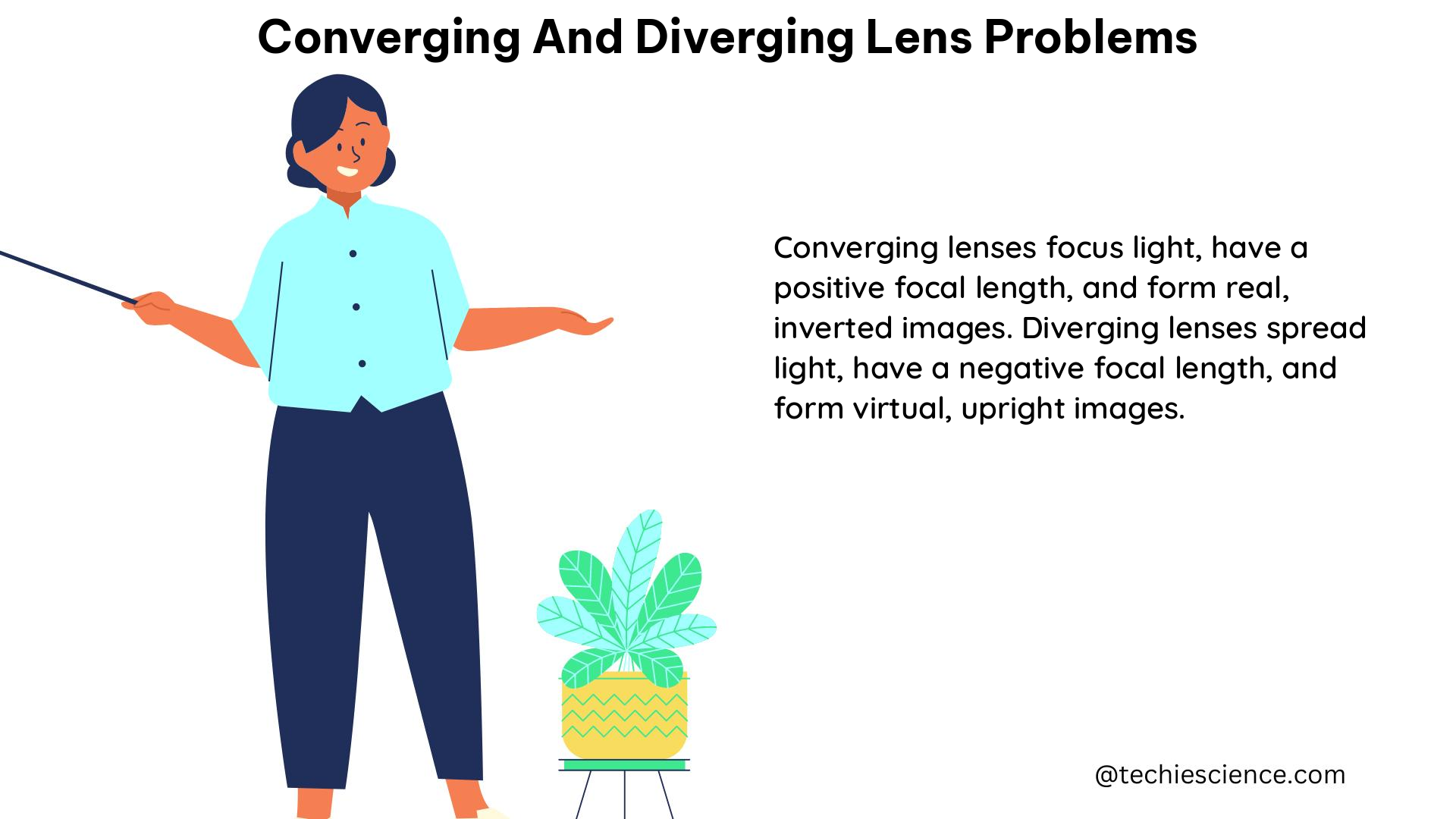Converging and diverging lenses are fundamental optical components that play a crucial role in various scientific and technological applications, from cameras and microscopes to telescopes and eyeglasses. Understanding the principles, calculations, and problem-solving techniques associated with these lenses is essential for physics students. In this comprehensive guide, we will delve into the technical specifications, theoretical explanations, theorems, physics formulae, examples, and numerical problems related to converging and diverging lens problems.
Technical Specifications and Theoretical Explanation
Converging Lenses
Converging lenses, also known as convex lenses, are thicker at the center than at the edges. These lenses have a positive focal length (f) and have the ability to bring light rays to a focus, creating a real image. The focal length of a converging lens is the distance from the lens to the point where parallel light rays converge.
Diverging Lenses
Diverging lenses, on the other hand, are thinner at the center than at the edges. These lenses have a negative focal length and spread light rays, creating a virtual image. The focal length of a diverging lens is the distance from the lens to the point where parallel light rays appear to diverge.
Thin Lens Equation
The relationship between the object distance (do), image distance (di), and focal length (f) of a thin lens is described by the thin lens equation:
1/f = 1/do + 1/di
Here, the focal length (f) is positive for converging lenses and negative for diverging lenses.
Magnification Equation
The magnification (M) of a lens is the ratio of the image height (hi) to the object height (ho), and is given by the magnification equation:
M = -di/do
A positive magnification indicates an upright image, while a negative magnification indicates an inverted image.
Physics Formulae and Examples

Example 1: Converging Lens
A 4.00-cm tall object is placed 8.30 cm from a double convex lens with a focal length of 15.2 cm. Using the thin lens equation, we can calculate the image distance and magnification:
1/f = 1/do + 1/di
1/15.2 = 1/8.30 + 1/di
di = 18.3 cm
The image is enlarged, upright, and 8.81-cm tall, located 18.3 cm from the lens on the object’s side.
Example 2: Converging Lens
A 5-cm tall object is placed 45.0 cm from a double convex lens with a focal length of 15.0 cm. Using the thin lens and magnification equations, we can determine the image distance and magnification:
1/f = 1/do + 1/di
1/15.0 = 1/45.0 + 1/di
di = 22.5 cm
M = -di/do
M = -(22.5 cm)/(45.0 cm)
M = -0.5
The image is real, inverted, and 2.5 cm tall, located 22.5 cm from the lens.
Numerical Problems
-
A 6.0-cm tall object is placed 20.0 cm in front of a converging lens with a focal length of 12.0 cm. Calculate the image distance and magnification.
-
A 3.0-cm tall object is placed 35.0 cm from a diverging lens with a focal length of -10.0 cm. Determine the image distance and magnification.
Solution 1:
Using the thin lens equation and magnification equation:
1/f = 1/do + 1/di
1/12.0 = 1/20.0 + 1/di
di = 30.0 cm
M = -di/do
M = -(30.0 cm)/(20.0 cm)
M = -1.5
The image is real, inverted, and 9.0 cm tall, located 30.0 cm from the lens.
Solution 2:
Using the thin lens equation and magnification equation:
1/f = 1/do + 1/di
1/-10.0 = 1/35.0 + 1/di
di = -17.5 cm
M = -di/do
M = -(-17.5 cm)/(35.0 cm)
M = 0.5
The image is virtual, upright, and 1.5 cm tall, located 17.5 cm from the lens on the opposite side of the object.
Additional Considerations
- Converging lenses can be used to create real, inverted images (as in a camera) or virtual, upright images (as in a magnifying glass).
- Diverging lenses always create virtual, upright images.
- The size and position of the image depend on the object distance and the focal length of the lens.
- Lens aberrations, such as spherical and chromatic aberrations, can affect the quality of the image produced by a lens.
- The use of multiple lenses, such as in a compound microscope or a telescope, can further manipulate the image formation and magnification.
References
- 24-8 An Example Problem Involving a Lens – WebAssign
- Modeling the Thin Lens Equation – Arbor Scientific
- Analyzing Errors in Converging Lens Calculations – Physics Forums
- The Mathematics of Lenses – The Physics Classroom
- Converging and Diverging Thin Lens Problems – YouTube

The lambdageeks.com Core SME Team is a group of experienced subject matter experts from diverse scientific and technical fields including Physics, Chemistry, Technology,Electronics & Electrical Engineering, Automotive, Mechanical Engineering. Our team collaborates to create high-quality, well-researched articles on a wide range of science and technology topics for the lambdageeks.com website.
All Our Senior SME are having more than 7 Years of experience in the respective fields . They are either Working Industry Professionals or assocaited With different Universities. Refer Our Authors Page to get to know About our Core SMEs.